| Listing 1 - 7 of 7 |
Sort by
|
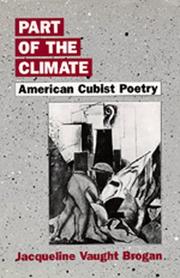
ISBN: 0520068483 Year: 1991 Publisher: Berkeley Los Angeles Oxford University of California Press
Abstract | Keywords | Export | Availability | Bookmark
 Loading...
Loading...Choose an application
- Reference Manager
- EndNote
- RefWorks (Direct export to RefWorks)
American poetry --- 20th century --- History and criticism --- Art and literature --- United States --- History --- Cubism and literature --- AMERICAN POETRY --- ART AND LITERATURE --- CUBISM AND LITERATURE --- 20th CENTURY --- HISTORY AND CRITICISM --- US --- HISTORY
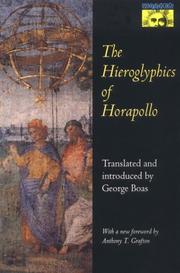
ISBN: 0691000921 0691061696 0691215065 Year: 1969 Publisher: [Princeton, N.J.] : Princeton University Press,
Abstract | Keywords | Export | Availability | Bookmark
 Loading...
Loading...Choose an application
- Reference Manager
- EndNote
- RefWorks (Direct export to RefWorks)
Written reputedly by an Egyptian magus, Horapollo Niliacus, in the fourth century C.E., 'The Hieroglyphics of Horapollo' is an anthology of nearly two hundred "hieroglyphics," or allegorical emblems, said to have been used by the Pharaonic scribes in describing natural and moral aspects of the world. Translated into Greek in 1505, it informed much of Western iconography from the sixteenth through the nineteenth centuries. This work not only tells how various types of natural phenomena, emotions, virtues, philosophical concepts, and human character-types were symbolized, but also explains why, for example, the universe is represented by a serpent swallowing its tail, filial affection by a stork, education by the heavens dropping dew, and a horoscopist by a person eating an hourglass.In his introduction Boas explores the influence of 'The Hieroglyphics' and the causes behind the rebirth of interest in symbolism in the sixteenth century. The illustrations to this edition were drawn by Albrecht Drer on the verso pages of his copy of a Latin translation.
Painting --- Photography --- American literature --- Williams, William Carlos --- Stieglitz, W. --- anno 1910-1919 --- Art and literature --- Cubism and literature. --- History --- Williams, William Carlos, --- Stieglitz, Alfred, --- Knowledge --- Art. --- Influence.
Book
Year: 1987 Volume: 10 Publisher: Roma : Bulzoni,
Abstract | Keywords | Export | Availability | Bookmark
 Loading...
Loading...Choose an application
- Reference Manager
- EndNote
- RefWorks (Direct export to RefWorks)
Cubism and literature --- Experimental poetry --- Poetry, Modern --- Sound poetry --- Visual poetry --- Cubisme et littérature --- Poésie expérimentale --- Poésie --- Poésie sonore --- Poésie visuelle --- History and criticism --- Histoire et critique
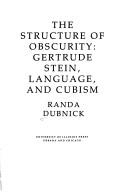
ISBN: 0252009096 9780252009099 Year: 1984 Publisher: Urbana (Ill.): University of Illinois press,
Abstract | Keywords | Export | Availability | Bookmark
 Loading...
Loading...Choose an application
- Reference Manager
- EndNote
- RefWorks (Direct export to RefWorks)
American literature --- Art styles --- Stein, Gertrude --- anno 1910-1919 --- Cubism and literature --- Cubisme et littérature --- Stein, Gertrude, --- Style --- Knowledge --- Art --- Women and literature --- Art and literature --- History --- Literary style --- Cubisme et littérature --- Style. --- Art. --- Women and literature - United States - History - 20th century --- Art and literature - United States - History - 20th century --- Stein, Gertrude, - 1874-1946 - Literary style --- Stein, Gertrude, - 1874-1946
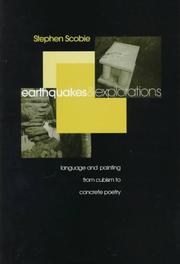
ISBN: 144266486X 9781442664869 0802041418 9780802041418 9781442613201 1442613203 Year: 1997 Publisher: Toronto, [Ontario] ; Buffalo, [New York] ; London, [England] : University of Toronto Press,
Abstract | Keywords | Export | Availability | Bookmark
 Loading...
Loading...Choose an application
- Reference Manager
- EndNote
- RefWorks (Direct export to RefWorks)
The author's concern is both with a general theoretical question - the relationship between painting and poetry, between the visual and the verbal - and with a specific period of artistic history - the early years of the twentieth century, when Cubism flourished. Rather than seeing any conflict or irreconcilable division between painting and poetry, Scobie proposes, as a model for their relation, the Derridean notion of 'the supplement.' This relation is grounded in the pervasiveness of language, in the ways in which language surrounds, imbues, structures, and supplements both verbal and nonverbal images.
Cubism and literature. --- Art and literature. --- Painting, Modern --- Concrete poetry --- Groupe Mémoires (Group of artists) --- Literature and art --- Literature and painting --- Literature and sculpture --- Painting and literature --- Sculpture and literature --- Aesthetics --- Literature --- Literature and cubism --- History and criticism. --- Cubisme et litterature
Book

ISBN: 9782711879779 2711879771 Year: 2023 Publisher: Paris : Réunion des musées nationaux,
Abstract | Keywords | Export | Availability | Bookmark
 Loading...
Loading...Choose an application
- Reference Manager
- EndNote
- RefWorks (Direct export to RefWorks)
Braque, Georges ; Cézanne, Paul ; Gris, Juan ; Lipchitz, Jacques ; Matisse, Henri ; Andre, Carl ; Byars, James Lee ; Darboven, Hanne ; Duchamp, Marcel ; Gallagher, Ellen ; Hill, Gary ; Indiana, Robert ; Johns, Jasper ; Johson, Ray ; Kass, Deborah ; Kosuth, Joseph ; LeWitt, Sol et al.
Cubisme. --- Cubisme et littérature. --- Stein, Gertrude --- Picasso, Pablo --- Amis et relations. --- Cubisme et littérature. --- Cubism --- Cubism and literature --- Picasso, Pablo, --- Stein, Gertrude, --- Friends and associates --- Cubism and litterature --- Friends and associates. --- Women art collectors --- Art, Modern --- Painting, French --- Painting, American --- Portrait painting --- Stein, Gertrude. --- Picasso, Pablo.
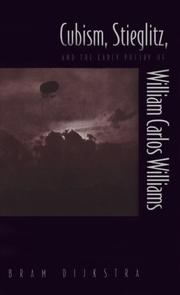
ISBN: 0691013454 0691061696 0691215065 0691216134 Year: 1989 Publisher: Princeton Princeton University Press
Abstract | Keywords | Export | Availability | Bookmark
 Loading...
Loading...Choose an application
- Reference Manager
- EndNote
- RefWorks (Direct export to RefWorks)
Written reputedly by an Egyptian magus, Horapollo Niliacus, in the fourth century C.E., 'The Hieroglyphics of Horapollo' is an anthology of nearly two hundred "hieroglyphics," or allegorical emblems, said to have been used by the Pharaonic scribes in describing natural and moral aspects of the world. Translated into Greek in 1505, it informed much of Western iconography from the sixteenth through the nineteenth centuries. This work not only tells how various types of natural phenomena, emotions, virtues, philosophical concepts, and human character-types were symbolized, but also explains why, for example, the universe is represented by a serpent swallowing its tail, filial affection by a stork, education by the heavens dropping dew, and a horoscopist by a person eating an hourglass.In his introduction Boas explores the influence of 'The Hieroglyphics' and the causes behind the rebirth of interest in symbolism in the sixteenth century. The illustrations to this edition were drawn by Albrecht Drer on the verso pages of his copy of a Latin translation.
Cubism and literature --- Art and literature --- -Literature and cubism --- Literature and art --- Literature and painting --- Literature and sculpture --- Painting and literature --- Sculpture and literature --- History --- -Stieglitz, Alfred --- -Williams, William Carlos --- -Influence --- Knowledge --- -Art --- American literature --- Photography --- Painting --- Williams, William Carlos --- Stieglitz, W. --- anno 1910-1919 --- Literature and cubism --- Literature --- Stieglitz, Alfred, --- Williams, William Carlos, --- וויליאמס, וויליאם קרלוס, --- ויליאמס, ויליאם קרלוס, --- O'Keeffe, Georgia, --- Influence. --- Art. --- Cubism and literature. --- Cubism --- Cubisme --- Criticism and interpretation --- Stieglitz, Alfred --- Influence --- Avant-Garde (Aesthetics) --- United States --- Art [Modern ] --- 20th century --- Criticism and interpretation. --- Ṿiliʼams, Ṿiliʼam Ḳarlos, --- Absence of ants. --- Aphrodite. --- Birth, deformed. --- Boundaries. --- Circle. --- Copulation. --- Death. --- Discrimination. --- Distribution of justice. --- Egypt. --- Eternity. --- Filial affection. --- Foreknowledge. --- Gluttony. --- Gratitude. --- Heavens. --- Hephaistus. --- Horoscopist. --- Impurity. --- Infinity. --- Judge. --- Lawlessness. --- Loins. --- Magistrate. --- Measurement. --- Night. --- Pederasty. --- Plunderer. --- Recklessness. --- Sluggishness. --- Sublime. --- Temperance. --- Twilight. --- Unanimity. --- Unstable man. --- Victory. --- Wasp. --- Widow.
| Listing 1 - 7 of 7 |
Sort by
|

 Search
Search Feedback
Feedback About UniCat
About UniCat  Help
Help News
News